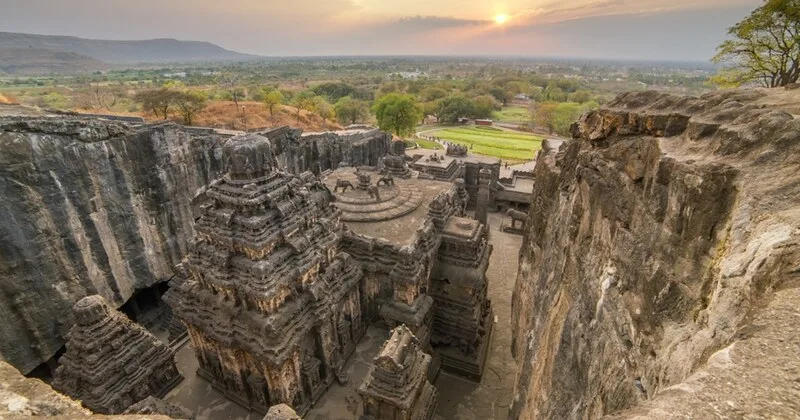The Kailasa Mandir, also known as Cave 16, is a stunning part of the Ellora Caves in Maharashtra, a popular tourist destination. This incredible Mandir is carved out of a single rock, making it one of the largest monolithic structures in the world. It’s not just its size that impresses visitors but also its intricate sculptures and exquisite architectural details.
The Kailasa Mandir stands out as one of India’s most remarkable cave Mandirs, drawing admiration for its artistic and architectural brilliance. The Great Kailasa Mandir, dedicated to Bhagwan Shiva, is a stunning multi-story structure that stands on its own, attracting visitors from around the world. This 1,300-year-old marvel is carved entirely from a single volcanic basaltic rock of the Charanandri hills, making it the largest monolithic piece of art in India and the world.

The intricate sculptures, also carved from the same rock, add to its mystique. The Mandirs architecture reflects Pallava and Chalukya styles, showcasing a blend of ancient Indian artistry. A key attraction in Ellora, the Great Kailasa Mandirs, is a must-visit on any tour of Aurangabad.
The Kailasa Mandir, known for its unique vertical excavation, is an architectural wonder where construction began at the top and moved downward, using steel rod drills to split and remove large boulders. Visitors can still see the drill marks on the surrounding walls. This remarkable temple, carved from a single rock, is the only structure in the world created from the top down.
Each design and measurement had to be perfectly planned since there was no way to alter it once cut. Legend says about 200,000 tonnes of rock were removed to build this monolithic structure. While archaeologists estimated it would take over a hundred years to complete, the temple was actually finished in just 18 years.
The rock-cut temple forms a U-shape, extending about 50 meters into the mountain, with an incredible 200,000 tonnes of rock removed from a vertical basalt cliff in the Charanandri Hills to create this magnificent site. The Kailasa Mandir stands as a testament to ancient engineering and architectural prowess. The Kailasa Mandir is one of India’s most remarkable cave Mandirs, celebrated for its enormous size, stunning architecture, and intricate sculptures.
Measuring about 145 feet wide, 195 feet long, and 90 feet high, it covers an area twice that of the Parthenon in Athens, Greece. The Mandir features a massive sculpted monolithic main shrine at its center, with gopuras and enclosure walls on both sides. This makes the Kailasa Mandir one of the largest structures not only in India but in the world, rivalling even the grandeur of the Taj Mahal in Agra.
There’s an intriguing story about the Kailasa Mandir at Ellora involving Mughal King Aurangzeb, who was known for destroying thousands of Hindu Mandirs. In 1682, Aurangzeb sent 1,000 men to demolish the Kailasa Mandir. Despite working for three years, they managed to only damage a few statues.
Aurangzeb eventually abandoned the effort, realising that the temple’s rock was too hard to destroy. This failure highlighted the incredible craftsmanship of the artisans who, using only hammers, chisels, and picks, constructed a Mandir that even an army couldn’t demolish. A medieval Marathi legend sheds light on the construction of the Kailasa Mandir.
The earliest mention of this tale is found in the text *Katha-Kalapataru* by Krishna Yajnavalki. According to the legend, a local king was suffering from a severe illness. His queen prayed to the god Ghrishneshwar (Shiva) at Elapura for his recovery, vowing to build a temple and fasting until she could see its shikhara (top).
After the king was cured, the queen urged him to build the Mandir immediately. Many architects said it would take months to complete. However, an architect named Kokasa promised the king that the queen would see the shikhara within a week.
Kokasa began carving the Mandir from the top of a rock and completed the shikhara in just one week, allowing the queen to end her fast. The temple was named Manikeshwar in her honour. Historian M K Dhavalikar theorises that Kokasa was indeed the chief architect of the Kailasa Mandir, which may have originally been known as Manikeshwar.
The Kailasa Mandir is an amazing example of ancient Indian skill and devotion. Carved from a single rock, it is one of the largest and most detailed structures of its kind in the world. Its unique top-down construction, beautiful sculptures, and careful design continue to impress visitors from all over the world.
The story of its quick building, Mughal King Aurangzeb’s failed attempt to destroy it, and the brilliant work of architect Kokasa make it even more special. Originally called Manikeshwar, the temple shows human creativity, hard work, and spiritual devotion. Visiting the Kailasa Mandir gives a deep look into India’s rich history and reminds us of the incredible achievements of ancient times.
It is a must-see for anyone exploring the historic and cultural sites of Aurangabad and beyond..



















